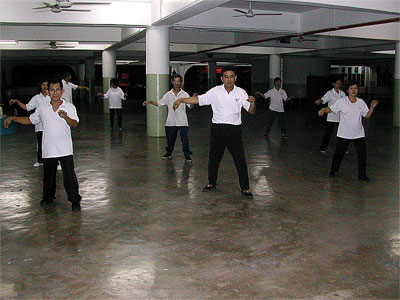|
Uniqueness of
Master Koh's Training Methods
by a student of Master Koh (July 2006)
The most common approach to Taiji pushing hands training
is the external or hard style approach.
Here, opponent's attacks (forces) are blocked, intercepted,
parried off, sticked to, circumplayed, off-balanced,
etc. all externally with the use of one's arms. Such
approach can commonly be seen in non-Taiji styles such
as Wing Chun, Akido, and from a plethora of cheap commercial
VCDs from mainland China, featuring Yang style, Chen
style, etc.
This approach can be seen to be very
superficial and external. As one parries, blocks, intercepts,
etc., to avoid ever letting an opponent brute forces,
land on one's body, an egoistic element is present -
the element of fear of losing. In real life or death
situations, this is totally understandable and acceptable.
However, in training sessions
where sparing partners are trusted brothers-in-the-
art, this approach makes no sense at all. Obvious disadvantages
are many and clear - we will never ever get to understand
forces, let alone how to yield, absorb or return them,
if we only feel such forces externally (intercepted),
and not internally onto our body.
Here is where the uniqueness of Master
Koh shines. His mantra is to learn. To do so, we must
believe in Prof. Cheng Man Ching's principle of "investing
in loss". Master Koh's approach to pushing hands
practice is exactly the opposite of those mentioned
earlier.
Here, Master Koh approach is very internal.
He allows opponent's forces onto and into his body.
He actually encourages it. What better
way to understand forces, jing and all its intricacies,
than to allow them to come into our body. Sure, we'll
get "beaten" up but only in practices,
and by friendly trusted sparring partners. "Invest
in loss" is the only way to truly learn.
Of course there are rules and principles
to encourage such learning - be song, no sudden jolts
(no chance to ever learn anything this way), listen
tentatively (ting jing), etc. The primary goal is to
learn, not to feed our egos by beating up our sparring
partner.
Once the art is mastered, real live
situations can then be less fearsome, from the understanding
and confidence developed.
Benefits from this unorthodox approach
of Master Koh, includes the development of good rooting,
superb ting jing (sensitivity/listening power), deep
tung jing (understanding forces), subtle jie jing (receive/absorb
forces), and ultimately, powerful fa jing (repel/repluse
power).
One contradiction is that we may get
demoralized at times, from losing all the time; and
the process seemingly longer to master. However, the
learning curve is exponential and there is no looking
back once it takes off. If it was that easy to master,
it can't be that good.
| |

|
|
|
|
|
| |
Tan
Pien - Single Whip
|
|
<
back to Articles
|




